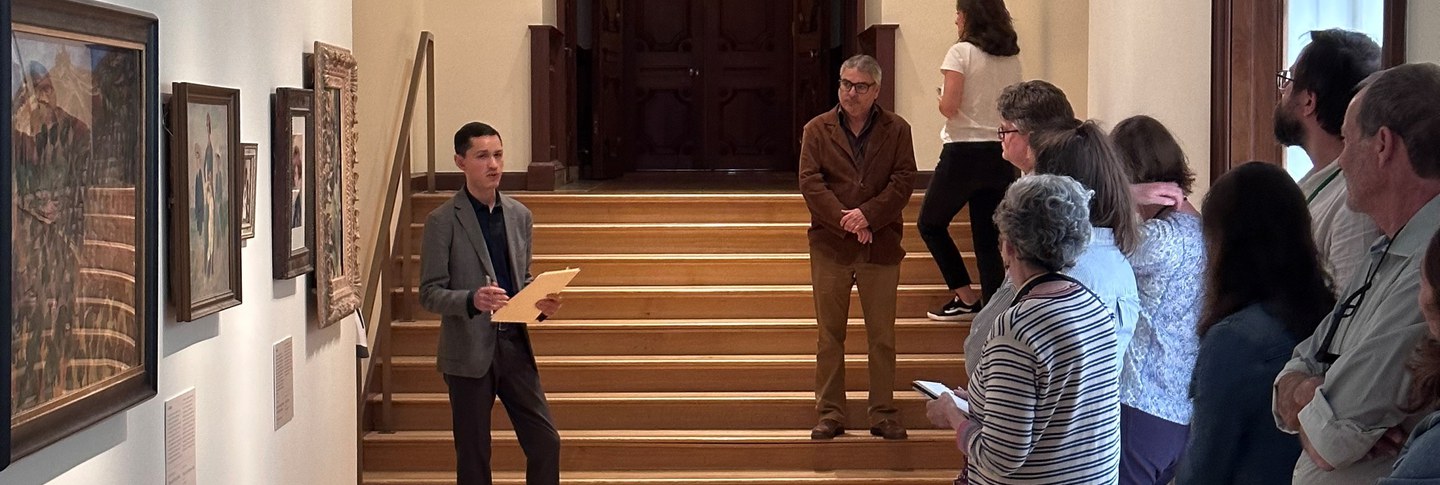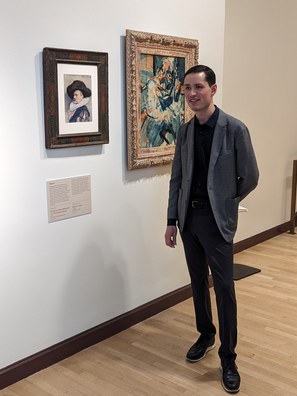As a post-baccalaureate curatorial fellow in 2018–2019, Samuel Shapiro—now a PhD candidate in Art History at Princeton—looked for ways to utilize his interest in twentieth-century art history. He found a project in the paintings of Dumbarton Oaks’ House Collection, which includes approximately 1,200 western European paintings, sculptures, tapestries, and furnishings from the Gothic, Renaissance, Baroque, Rococo, and modern periods, as well as ancient Egyptian and Asian Art. Rather than creating an exhibition fitting the House Collection’s paintings into national schools as previous exhibitions had done, Shapiro approached the collection from the perspective of the collectors: Mildred Barnes Bliss and Robert Woods Bliss.
Contemporaries, now on view in the Special Exhibition corridor, offers a glimpse into the Blisses’ tastes and how they made sense of their experience of changing societal conditions. The sampling of ten paintings spans a thirty-five-year period starting at the beginning of the twentieth century. As the exhibition text acknowledges, this cross-section was “shaped by the cares and concerns, biases and blind spots, of the Blisses.” It alludes to both the Blisses’ philanthropic efforts during World War I as well as the relative luxury in which they and those in their social circle lived.
For example, their friend Walter Gay spent the war in the Parisian suburbs at his mansion, Château du Bréau—the setting for his paintings The Open Window, Le Bréau and Les Tableaux, Le Bréau. Certainly, this was not an easy time for Gay, who recalled hearing German bombers overhead on their way to Paris. But the contrast to the war experiences of other painters featured in the exhibition—including Duvent, who sketched on the front as “Painter to the Armies,” and Willy Eisenschitz, who was held in an Austrian internment camp as a “foreigner”—is stark.
In preparation for the exhibition, current post-baccalaureate curatorial fellow Lizzie McCord researched the Blisses’ World War I experiences using the letters they exchanged with their friends Royall and Elisina Tyler, who were living in France. The Blisses and the Tylers experienced the byproducts of the war, including losing a close friend in battle in 1916. However, their correspondence also highlights the protection that wealth afforded them. In a September 30, 1914 letter to Mildred Bliss, Elisina Tyler wrote, “We are spared all sad scenes—the saddest I have witnessed was the passing of a train of poor refugees from the North, forlorn and resigned-looking. The poor old people about here are to be pitied, as in many cases the mainstay of the family is at the front, and the rest are left unprovided-for.”
Elisina Tyler’s words perhaps suggest a motivation for the Blisses’ philanthropy during the war—the recognition that they were far more fortunate than many. Yet they also make explicit that the Blisses, and those in their circle, were “spared all sad scenes.”
In his gallery talk on May 23, Shapiro noted that while development of Contemporaries began before the COVID-19 pandemic, the pandemic had inevitably shaped the end product. “[The exhibition] became more interesting through the pandemic, for among its themes are making art at a time of crisis, collecting art as a means of processing a rapidly changing world, and how our experiences of time are both shared and incommensurable,” Shapiro shared. Certainly, Elisina Tyler’s words could be applied to the pandemic, during which we have seen how a profound collective experience has been felt dramatically differently depending on one’s access to wealth.
Contemporaries, then, is both a display of the literal contemporaries of Dumbarton Oaks’ founders, and an exhibition that questions what a contemporary is in times when experiences of the same moment can vastly differ and experiences across centuries can be eerily alike.
Lizzie McCord is the 2021-23 curatorial fellow at Dumbarton Oaks.


